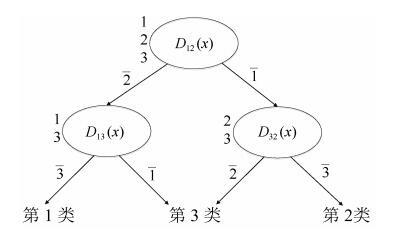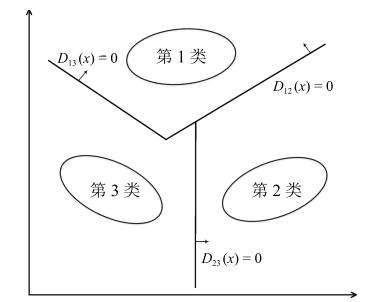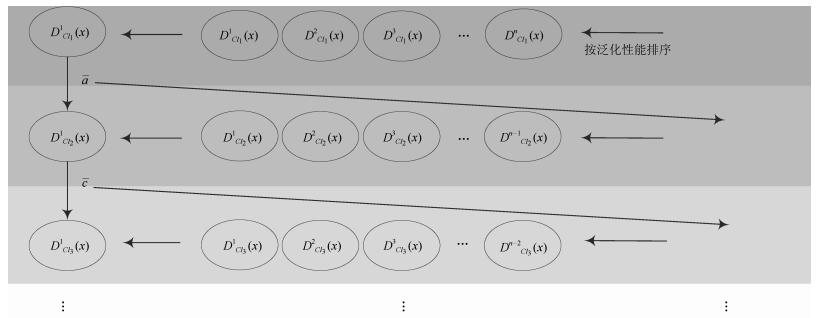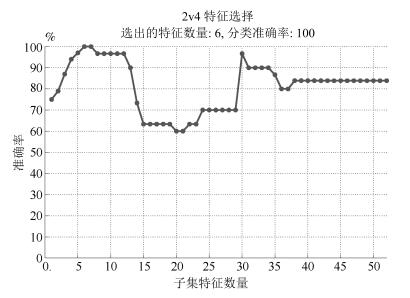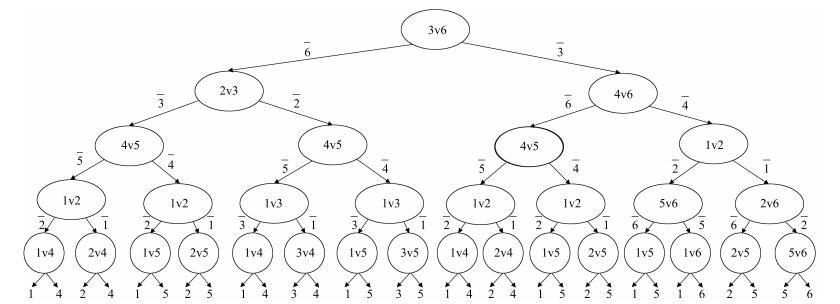A Structure-optimized DDAG-SVM Action Recognition Method for Upper Limb Rehabilitation Training
-
摘要: 针对上肢康复训练系统中训练评估方法核心的动作识别问题, 提出一种面向Brunnstrom 4~5期患者上肢康复训练动作的SODDAG-SVM (Structure-optimized decision directed acyclic graph-support vector machine)多分类识别方法.首先将多分类问题分解成一组二分类问题, 并使用支持向量机构建各二分类器, 分别采用遗传算法和特征子集区分度准则对各二分类器的核函数参数及特征子集进行优化.然后使用类对的SVM二分类器泛化误差来衡量每个类对的易被分离程度, 并由其建立类对泛化误差上三角矩阵.最后由根节点开始, 依次根据各节点的泛化误差矩阵, 通过选择其中最易被分离类对的SVM分类器构成该节点的方式, 来构建SODDAG-SVM多分类器结构.当待预测的实例较少时, 直接构建实例经过的SODDAG-SVM部分结构并对实例进行预测; 当待预测的实例较多时, 先构建完整的SODDAG-SVM结构, 再代入所有实例进行预测.通过人体传感技术获得Brunnstrom 4~5阶段上肢康复训练的常用动作样本集, 进行SODDAG-SVM动作识别实验, 准确率达到了95.49%, 结果均优于常规的决策有向无环图(Decision directed acyceic graph, DDAG)和MaxWins方法, 实验表明本文方法能有效地提高上肢康复训练动作识别的准确率.
-
关键词:
- 上肢康复训练 /
- 动作识别 /
- SODDAG-SVM /
- 多分类器 /
- 二分类器
Abstract: An SODDAG-SVM (structure-optimized decision directed acyclic graph-support vector machine) multi-classification action recognition method of upper limb rehabilitation training for the Brunnstrom 4~5 stage patients is proposed to solve the core problem of action recognition of the rehabilitation training evaluation method. First, the multi-classification problem is decomposed into a set of binary classification problems, support vector machine (SVM) method is used to construct each binary classifier, in which the SVM kernel function parameters and feature subsets of each binary classifiers are optimized by genetic algorithm and the feature subsets discrimination criterion, respectively. Then, the generalization errors of each SVM binary classifier are used to measure the separable degree of this class pair, and the upper triangulation matrix of generalization errors is built. Finally, from the root node, according to the generalization error matrix of each node, an SODDAG-SVM structure is constructed by choosing the SVM classifier of the most easily separated class pair as each node. When there are fewer instances to be predicted, a part of the SODDAG-SVM structure passed by these instances is directly built for predicting the instances. When more instances need to be predicted, a complete SODDAG-SVM structure is first constructed and then is used to predict all the instances. Action recognition experiment is performed on the upper limb routine rehabilitation training samples of the Brunnstrom 4~5 stage, acquired using human body sensing technology. Results show that the accuracy reaches 95.49% which is higher than those of conventional decision directed acyceic graph (DDAG) and MaxWins methods. It is proved that the proposed method can effectively improve the accuracy of rehabilitation training action recognition.-
Key words:
- Upper limb rehabilitation training /
- action recognition /
- structure-optimized decision directed acyclic graph-support vector machine (SODDAG-SVM) /
- multi-class classifier /
- binary classifier
1) 本文责任编委 白翔 -
表 1 $C$, $g$参数寻优结果
Table 1 Optimization results of the parameters of $C$, $g$
类对 最优$C$ 最优$g$ 最优准确率(%) 1v2 0.009793572 0.0022394 100 1v3 0.33971 1.08$\times 10^6$ 100 1v4 1 9.73$\times 10^6$ 95.5517 1v5 0.613049119 0.001941097 89.6552 1v6 1.10$\times 10^6$ 0.00721982 95.4371 2v3 1 0.000019687 88.6836 2v4 0.023029107 0.019702158 83.8836 2v5 0.967574582 0.003192183 100 2v6 1 7.00$\times 10^13$ 100 3v4 0.5 0.000033106 90 3v5 0.25 6.03$\times 10^6$ 96.6689 3v6 1 0.000047963 86.6545 4v5 0.26493253 0.008829793 83.3582 4v6 0.825159853 0.020969172 88.6883 5v6 3.1249 0.000052136 86.6667 表 2 特征子集选择结果
Table 2 Feature subset selection results
类对 最优特征子集 测试集准确率(%) 1v2 全部特征 100 1v3 全部特征 100 1v4 16, 1, 38, 25, 29, 7, 11, 20, 33, 50, 17, 30, 47 100 1v5 26, 39, 1 95.4767 1v6 26, 37 95 2v3 37, 24, 46 100 2v4 16, 29, 47, 37, 24, 21 100 2v5 21, 16, 29, 47, 34, 50, 37, 24, 46, 39, 26, 43, 13, 1, 52, 25, 32, 38, 45, 19, 4, 11, 41, 20, 28, 15, 42 100 2v6 39, 37, 24, 47, 50, 26, 21 100 3v4 37, 46, 42 94.6536 3v5 27, 14, 46, 42, 39, 26, 21, 17, 41, 13, 51, 30, 50, 16, 8, 7, 32, 19, 45 95.3467 3v6 13, 39, 26, 46, 17, 30, 42 100 4v5 29, 16, 39, 26, 19 100 4v6 39, 16, 26, 13, 29, 24 100 5v6 16 100 表 3 分类准确率对比(%)
Table 3 Comparison of classification accuracy(%)
DDAG SODDAG MaxWins 平均值 92.09 95.49 91.04 最大值 96.89 / / 最小值 89.83 / / 表 4 时间开销对比(s)
Table 4 Comparison of time cost (s)
DDAG SODDAG MaxWins 时间 0.7459 1.0167 1.5723 表 5 SODDAG-SVM混淆矩阵
Table 5 SODDAG-SVM confusion matrix
类别 1 2 3 4 5 6 1 180 0 0 0 12 8 2 0 200 0 0 0 0 3 0 0 182 9 9 0 4 0 0 6 194 0 0 5 3 0 4 0 193 0 6 3 0 0 0 0 197 表 6 类对1v5混淆矩阵
Table 6 1v5 class pair confusion matrix
类别 1 5 1 186 14 5 4 196 表 7 类对1v6混淆矩阵
Table 7 1v6 class pair confusion matrix
类别 1 6 1 187 13 6 7 193 表 8 类对3v4混淆矩阵
Table 8 3v4 class pair confusion matrix
类别 3 4 3 191 9 4 12 188 表 9 类对3v5混淆矩阵
Table 9 3v5 class pair confusion matrix
类别 3 5 3 190 10 5 9 191 -
[1] Alamri F F, Al Shoyaib A, Biggers A, Jayaraman S, Guindon J, Karamyan V T. Applicability of the grip strength and automated von Frey tactile sensitivity tests in the mouse photothrombotic model of stroke. Behavioural Brain Research, 2018, 336: 250-255 doi: 10.1016/j.bbr.2017.09.008 [2] Saposnik G, Teasell R, Mamdani M, Hall J, McIlroy W, Cheung D, et al. Effectiveness of virtual reality using Wii gaming technology in stroke rehabilitation: a pilot randomized clinical trial and proof of principle. Stroke, 2010, 41(7): 1477-1484 doi: 10.1161/STROKEAHA.110.584979 [3] Kwakkel G, Kollen B J, van der Grond J, Prevo J H. Probability of regaining dexterity in the flaccid upper limb: impact of severity of paresis and time since onset in acute stroke. Stroke, 2003, 34(9): 2181-2186 doi: 10.1161/01.STR.0000087172.16305.CD [4] Mancisidor A, Zubizarreta A, Cabanes I, Bengoa P, Jung J H. Kinematical and dynamical modeling of a multipurpose upper limbs rehabilitation robot. Robotics and Computer-Integrated Manufacturing, 2018, 49: 374-387 doi: 10.1016/j.rcim.2017.08.013 [5] 梁明, 窦祖林, 王清辉, 熊巍, 郑雅丹, 陈颖蓓, 等.虚拟现实技术在脑卒中患者偏瘫上肢功能康复中的应用.中国康复医学杂志, 2013, 28(2): 114-118 doi: 10.3969/j.issn.1001-1242.2013.02.004Liang Ming, Dou Zu-Lin, Wang Qing-Hui, Xiong Wei, Zheng Ya-Dan, Chen Ying-Bei, et al. Application of virtual reality technique in rehabilitation of hemiplegic upper extremities function of stroke patients. Chinese Journal of Rehabilitation Medicine, 2013, 28(2): 114-118 doi: 10.3969/j.issn.1001-1242.2013.02.004 [6] Trombetta M, Bazzanello Henrique P P, Brum M R, Colussi E L, De Marchi A C B, Rieder R. Motion Rehab AVE 3D: a VR-based exergame for post-stroke rehabilitation. Computer Methods and Programs in Biomedicine, 2017, 151: 15 -20 doi: 10.1016/j.cmpb.2017.08.008 [7] 李雅楠, 左国坤, 崔志琴, 徐佳琳.虚拟现实技术在康复训练中的应用进展.中国康复医学杂志, 2017, 32(9): 1091-1094 doi: 10.3969/j.issn.1001-1242.2017.09.028Li Ya-Nan, Zuo Guo-Kun, Cui Zhi-Qin, Xu Jia-Lin. Application progress of virtual reality technology in rehabilitation training. Chinese Journal of Rehabilitation Medicine, 2017, 32(9): 1091-1094 doi: 10.3969/j.issn.1001-1242.2017.09.028 [8] 顾莹, 田利华, 陈红.虚拟现实训练系统和康复作业治疗在偏瘫患者上肢功能障碍中的应用.中国康复医学杂志, 2011, 26(6): 579- 581 doi: 10.3969/j.issn.1001-1242.2011.06.021Gu Ying, Tian Li-Hua, Chen Hong. Application of virtual reality training system and rehabilitation operation in upper limb dysfunction of hemiplegic patients. Chinese Journal of Rehabilitation Medicine, 2011, 26(6): 579-581 doi: 10.3969/j.issn.1001-1242.2011.06.021 [9] Mouawad M R, Doust C G, Max M D, McNulty P A. Wii-based movement therapy to promote improved upper extremity function post-stroke: a pilot study. Journal of Rehabilitation Medicine, 2011, 43(6): 527-533 doi: 10.2340/16501977-0816 [10] Burdea G C, Cioi D, Martin J, Fensterheim D, Holenski M. The Rutgers Arm Ⅱ rehabilitation system —— a feasibility study. IEEE Transactions on Neural Systems and Rehabilitation Engineering, 2010, 18(5): 505-514 doi: 10.1109/TNSRE.2010.2052128 [11] Park D S, Lee D G, Lee K, Lee G. Effects of virtual reality training using Xbox kinect on motor function in stroke survivors: a preliminary study. Journal of Stroke and Cerebrovascular Diseases, 2017, 26(10): 2313-2319 doi: 10.1016/j.jstrokecerebrovasdis.2017.05.019 [12] 锁建军, 杨红旗. Brunnstrom技术治疗脑梗死偏瘫病人临床观察.中西医结合心脑血管病杂志, 2017, 15(11): 1395-1398 doi: 10.3969/j.issn.1672-1349.2017.11.034Suo Jian-Jun, Yang Hong-Qi. Clinical observation of Brunn- strom technology in treatment of cerebral infarction patients with hemiplegia, Chinese and Western Medicine Journal of Cardiovascular and Cerebrovascular Diseases, 2017, 15(11): 1395-1398 doi: 10.3969/j.issn.1672-1349.2017.11.034 [13] 关秋菊, 罗晓牧, 郭雪梅, 王国利.基于隐马尔科夫模型的人体动作压缩红外分类.自动化学报, 2017, 43(3): 398-406 doi: 10.16383/j.aas.2017.c160130Guan Qiu-Ju, Luo Xiao-Mu, Guo Xue-Mei, Wang Guo-Li. Compressive infrared classification of human motion using HMM. Acta Automatica Sinica, 2017, 43(3): 398-406 doi: 10.16383/j.aas.2017.c160130 [14] 左国玉, 于双悦, 龚道雄.遥操作护理机器人系统的操作者姿态解算方法研究.自动化学报, 2016, 42(12): 1839-1848 doi: 10.16383/j.aas.2016.c160137Zuo Guo-Yu, Yu Shuang-Yue, Gong Dao-Xiong. Operator attitude algorithm for telerobotic nursing system. Acta Automatica Sinica, 2016, 42(12): 1839-1848 doi: 10.16383/j.aas.2016.c160137 [15] Yurtman A, Barshan B. Activity recognition invariant to sensor orientation with wearable motion sensors. Sensors, 2017, 17(8): Article No. 1838 [16] Foerster F, Smeja M, Fahrenberg J. Detection of posture and motion by accelerometry: a validation study in ambulatory monitoring. Computers in Human Behavior, 1999, 15(5): 571-583 doi: 10.1016/S0747-5632(99)00037-0 [17] Lee S H, Park H D, Hong S Y, Lee K J, Kim Y H. A study on the activity classification using a triaxial accelerometer. In: Proceedings of the 25th Annual International Conference of the IEEE Engineering in Medicine and Biology Society. Cancun, Mexico: IEEE, 2003. 2941-2943 [18] Karantonis D M, Narayanan M R, Mathie M, Lovell N H, Celler B G. Implementation of a real-time human movement classifier using a triaxial accelerometer for ambulatory monitoring. IEEE Transactions on Information Technology in Biomedicine, 2006, 10(1): 156-167 doi: 10.1109/TITB.2005.856864 [19] Khan A M, Lee Y K, Lee S Y, Kim T S. A triaxial accelerometer-based physical-activity recognition via augmented-signal features and a hierarchical recognizer. IEEE Transactions on Information Technology in Biomedi- cine, 2010, 14(5): 1166-1172 doi: 10.1109/TITB.2010.2051955 [20] Zhang M, Sawchuk A A. Human daily activity recognition with sparse representation using wearable sensors. IEEE Journal of Biomedical and Health Informatics, 2013, 17(3): 553-560 doi: 10.1109/JBHI.2013.2253613 [21] Vital J P M, Faria D R, Dias G, Couceiro M S, Coutinho F, Ferreira N M F. Combining discriminative spatiotemporal features for daily life activity recognition using wearable motion sensing suit. Pattern Analysis and Applications, 2017, 20(4): 1179-1194 doi: 10.1007/s10044-016-0558-7 [22] Ghaddar B, Naoum-Sawaya J. High dimensional data classification and feature selection using support vector machines. European Journal of Operational Research, 2018, 265(3): 993-1004 doi: 10.1016/j.ejor.2017.08.040 [23] Wu H F, Wang D Q, Huang Q, Gao L F. Real-time continuous recognition of knee motion using multi-channel mechanomyography signals detected on clothes. Journal of Electromyography and Kinesiology, 2018, 38: 94-102 doi: 10.1016/j.jelekin.2017.10.010 [24] Wang H F, Zheng B C, Yoon S W, Ko H S. A support vector machine-based ensemble algorithm for breast cancer diagnosis. European Journal of Operational Research, 2018, 267(2): 687-699 http://www.wanfangdata.com.cn/details/detail.do?_type=perio&id=c332f6be473abadc9f328e4c1d98eb65 [25] Platt J C, Cristianini N, Shawe-Taylor J. Large margin DAGs for multiclass classification. Advances in Neural Information Processing Systems, 1999, 12(3): 547-553 https://core.ac.uk/display/24720690 [26] Vapnik V N. An overview of statistical learning theory. IEEE Transactions on Neural Networks, 1999, 10(5): 988-999 doi: 10.1109/72.788640 [27] Dietterich T G. Ensemble methods in machine learning. In: Proceedings of the 1st International Workshop on Multiple Classifier Systems. Cagliari, Italy: Springer-Verlag, 2000. 1 -15 [28] Garcia L P F, Sáez J A, Luengo J, Lorena A C, de Carvalho A C P L F, Herrera F. Using the one-vs-one decomposition to improve the performance of class noise filters via an aggregation strategy in multi-class classification problems. Knowledge-Based Systems, 2015, 90: 153-164 doi: 10.1016/j.knosys.2015.09.023 [29] Krawczyk B, Woźniak M, Herrera F. On the usefulness of one-class classifier ensembles for decomposition of multi-class problems. Pattern Recognition, 2015, 48(12): 3969- 3982 doi: 10.1016/j.patcog.2015.06.001 [30] Sesmero M P, Alonso-Weber J M, Gutierrez G, Ledezma A, Sanchis A. An ensemble approach of dual base learners for multi-class classification problems. Information Fusion, 2015, 24: 122-136 doi: 10.1016/j.inffus.2014.09.002 [31] Montañés E, Barranquero J, Díez J, del Coz J J. Enhancing directed binary trees for multi-class classification. Information Sciences, 2013, 223: 42-55 doi: 10.1016/j.ins.2012.10.011 [32] Hsu C W, Lin C J. A comparison of methods for multiclass support vector machines. IEEE Transactions on Neural Networks, 2002, 13(2): 415-425 http://web.cs.iastate.edu/~honavar/multiclass-svm.pdf [33] Xie J Y, Wang C X. Using support vector machines with a novel hybrid feature selection method for diagnosis of erythemato-squamous diseases. Expert Systems with Applications, 2011, 38(5): 5809-5815 doi: 10.1016/j.eswa.2010.10.050 [34] 谢娟英, 谢维信.基于特征子集区分度与支持向量机的特征选择算法.计算机学报, 2014, 37(8): 1704-1718 http://d.old.wanfangdata.com.cn/Periodical/jsjxb201408006Xie Juan-Ying, Xie Wei-Xin. Several feature selection algorithms based on the discernibility of a feature subset and support vector machines. Chinese Journal of Computers, 2014, 37(8): 1704-1718 http://d.old.wanfangdata.com.cn/Periodical/jsjxb201408006 -





 下载:
下载:
